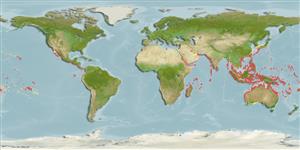Common names from other countries
Environment: milieu / climate zone / depth range / distribution range
Ekologi
marina; brackvatten revassocierade; djupintervall 0 - 20 m (Ref. 48637). Tropical
Indo-Pacific: East Africa to Samoa and the Hawaiian Islands.
Size / Vikt / Age
Maturity: Lm ? range ? - ? cm
Max length : 7.5 cm TL hane/ej könsbestämd; (Ref. 11344)
Short description
Bestämningsnycklar | Morfologi | Morfometri
Taggstrålar i ryggfenan (totalt) : 7; Mjukstrålar i ryggfenan (totalt) : 9; Taggstrålar i analfenan: 1; Mjukstrålar i analfenan: 8. Brown with irregular spots; dorsal and caudal fins with bands in females, dusky in males; often with dark brown saddle below each of the dorsal fins (Ref. 2798); characterized further by having upper five pectoral rays with free tips and sixth ray partly free; three branches on upper four pectoral rays; rounded caudal fin; longitudinal scale series 37-38; predorsal scales 18-20, reaching or nearly reaching interorbital space; cheek and opercle without scales; presence of fleshy double flap from edge of cheek into notch at posterior end of upper lip; ctenoid body scales, becoming cycloid on abdomen, breast, base of pectoral fin and nape; depressed head, width greater than depth; depth of body 4.3-5.5 in SL (Ref. 90102).
Inhabits intertidal seaward reef flats (Ref. 37816, 48637). Also found in shallow reefs near shore (Ref. 90102).
Life cycle and mating behavior
Maturities | Reproduktion | Spawnings | Egg(s) | Fecundities | Larver
Benthic spawner.
Randall, J.E. and M. Goren, 1993. A review of the gobioid fishes of the Maldives. Ichthyol. Bull. J.L.B. Smith Inst. Ichthyol. (58):1-37, 5 pls. (Ref. 9360)
IUCN Red List Status (Ref. 130435)
CITES (Ref. 128078)
Not Evaluated
Threat to humans
Harmless
Human uses
Verktyg
Special reports
Download XML
Internet-källor
Estimates based on models
Preferred temperature (Ref.
115969): 24.2 - 29.3, mean 28.2 (based on 3609 cells).
Phylogenetic diversity index (Ref.
82804): PD
50 = 0.5000 [Uniqueness, from 0.5 = low to 2.0 = high].
Bayesian length-weight: a=0.01023 (0.00477 - 0.02194), b=3.02 (2.84 - 3.20), in cm Total Length, based on LWR estimates for this (Sub)family-body shape (Ref.
93245).
Trofisk nivå (Ref.
69278): 3.4 ±0.5 se; based on size and trophs of closest relatives
Resiliens (Ref.
120179): Hög, lägsta populationsfördubblingstid mindre än 15 månader (Preliminary K or Fecundity.).
Fishing Vulnerability (Ref.
59153): Low vulnerability (10 of 100).
